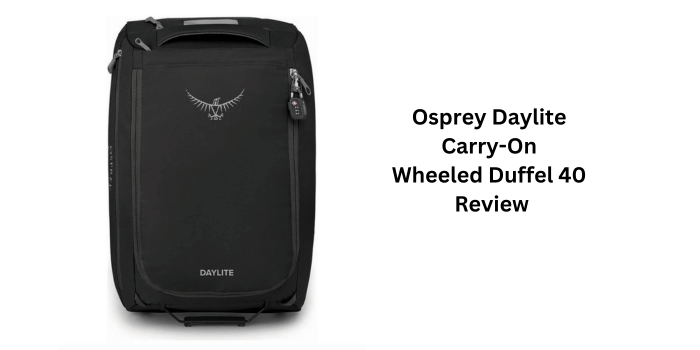What’s better: a travel backpack, duffel, or rolling luggage? If you’re on the fence about which one to choose, why not consider a hybrid model: a rolling bag that can quickly convert to a duffel or a backpack when circumstances warrant? My Osprey Daylite Carry-On Wheeled Duffel 40 review makes a strong case for considering such a bag.
Table of Contents
What is a hybrid travel bag?
Most hybrid travel bags convert from one model to another. The Osprey Daylite Carry-on Wheeled Duffel 40 involves three models: a duffel, backpack, and a wheeled suitcae.
A duffel bag typically has a single main compartment to carry travel gear of varying sizes and shapes. They’re made of soft-sided, durable materials for rough handling and being squeezed into tight spaces. Duffel bags have one or more carrying handles.
Rolling luggage has two or more wheels for pushing or pulling a bag.
A travel backpack is a favourite of travellers who value hands-free mobility and are comfortable carrying their travel gear on their backs.
My story: Travel backpack to a hybrid
For many years, I preferred a 40-litre travel backpack with a well-designed harness comprising a robust hip belt and adjustable sternum strap. This meant that the hips could absorb most of the packed weight, translating into the ability to use public transportation and walk reasonable distances with the bag. Its advantage over rolling luggage was that it meant travelling hands-free with enhanced mobility when dealing with steps and uneven surfaces. Another benefit is that the empty weight of a backpack tends to be lighter than that of wheeled luggage. Also, when wearing a backpack at a check-in counter, there’s less likelihood of being asked to remove it to verify its weight.
I bought the Osprey Farpoint 40 (38 litres in the S-M torso size) when it was marketed as a unisex bag. Osprey has since adapted the Farpoint with a few design changes to create the Fairview, which it promotes as a women’s travel bag. The Farpoint is now available in one size only and marketed as a men’s travel bag.
For my 46-day trip to Africa in 2023, I experimented with a rolling bag for the first time. Reluctant to abandon a backpack model, I chose a hybrid: the Osprey Daylite Carry-On Wheeled Duffel 40, a rolling, soft-sided duffel with detachable backpack straps.
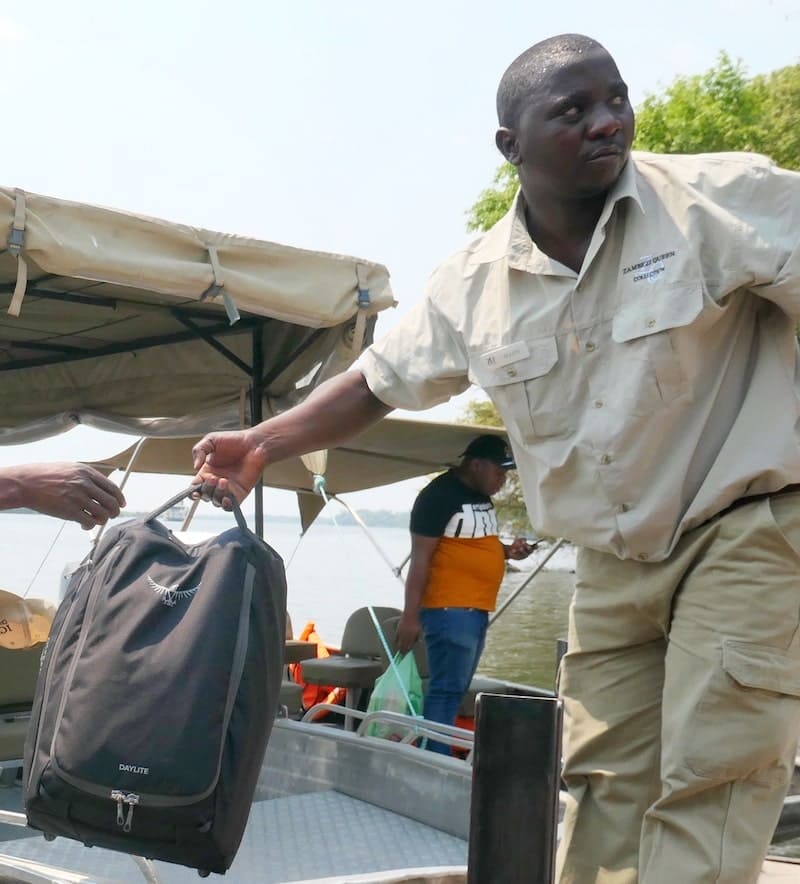
Osprey Daylite Carry-On Wheeled Duffel 40 review
After much research, I settled on the Osprey Daylite Carry-on Wheeled Duffel 40.
(i) Reasons to choose the Osprey Daylite Carry-On Wheeled Duffel 40
These are the significant factors influencing my choice.
1. Carry-on size
A bag in the 40-litre range meets the size of most airlines’ carry-on baggage requirements. While there are slight variations in the dimensions of allowable in-cabin luggage, I was satisfied that the Daylite’s measurements of 21.5 x 14 x 9 inches (54.61 x 35.56 x 22.86 centimetres) would be accepted by all airlines on my itinerary.
2. Lightweight
The most stringent carry-on limit of all airlines on my itinerary was 8 kg / 17.6 lb, so I was mindful of the empty weight of a bag without sacrificing quality and durability.
Weighing 4.9 lb (2.24 kg), it’s lighter than other wheeled travel backpacks under consideration. Since Osprey sent me a new bag under their ‘All Mighty Guarantee’ warranty covering ‘any reason, any product, any era,’ I’ve become a customer for life, so I looked to the hybrid carry-on bags in the Osprey inventory. These included the smaller 36-litre bags (Osprey Fairview 36 Wheeled Travel Backpack at 2.4 kg / 5.3 lb and the Osprey Farpoint Wheeled 36 Travel Pack at 2.5 kg / 5.5 lb), as well as the Osprey Transporter 40 Wheeled Duffel at 2.7 kg / 6 lb.
3. Organization
The Daylite boasts one sizable single compartment with a U-shaped zipper that opens like a suitcase. There are three zippered external pockets (a long, full-length side pocket, a small brain pocket with access to a luggage or ID tag window, and a deep front pocket), and a zippered internal mesh pocket.
Pockets, zippers, and other organizational elements add weight and expense to a travel bag. The existing pockets offered enough organizational elements to meet my needs.
4. Capacity
According to GearLab’s favourable review, the Daylite’s large main compartment has an interior volume of 43.5 litres. There’s plenty of packing space between and outside the rails of the retractable handle, and internal compression straps keep the contents snug and secure.
5. Two sturdy wheels
The Daylite was designed as an adventure bag. Each 3-inch inline skate wheel has a thick rubber all-terrain tread built for speed and navigating various surfaces, including gravel, grass, and cobblestones. With two wheels instead of four, fewer pieces can break or malfunction. Besides, after observing travellers pushing four-wheeled spinners on different surfaces (and negotiating steps), I decided that pulling a bag behind me would be faster and more comfortable than pushing a bag beside me.
6. Quality materials
The exterior shell is constructed of 100% recycled 450-denier polyester. This fine thread results in a strong, compressible, soft fabric that is abrasion-resistant and repels water better than ballistic nylon. The bottom is constructed of 100% recycled 900-dernier polyester, and the lining of 100% recycled 200-dernier polyester.
Protective rails and sturdy kick plates offer additional protection and durability.
There are two top and bottom grab handles. One is a metal support stand, and the other is thick with high-quality stitching for comfort and durability.
7. Deployable backpack straps
Unlike most backpack straps, the Daylite’s straps attach to the front of the bag. The comfortable, padded backpack straps have plastic hooks with metal clips to attach to loops at the bottom of the bag. The tucked-away straps can remain partially attached and stowed in the deep front pocket or removed and left at home.
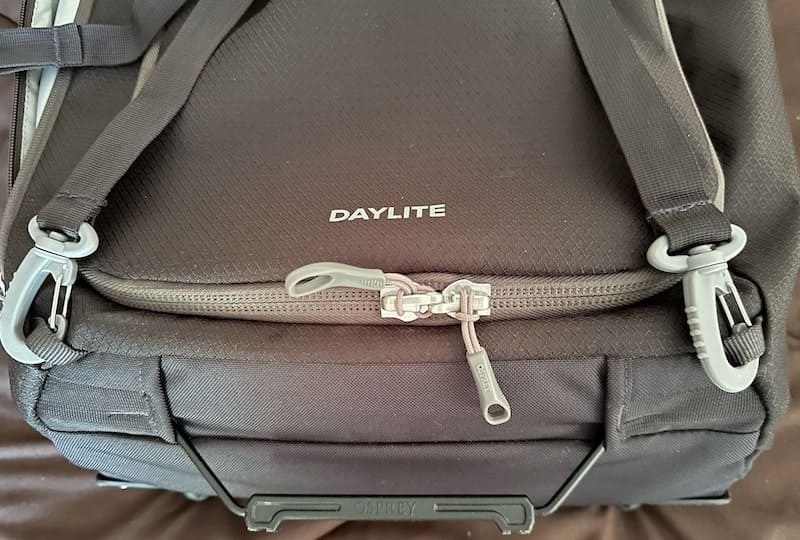
8. Telescopic extendable handle
The push-button, retractable aluminum handle has two uprights and two locking points. Having two uprights rather than one enhances the ability to attach a jacket or additional bag with a luggage sleeve or bungee luggage strap.
9. Lockable zippers
The heavy-duty interlocking zippers on the main compartment can be secured with a lock.
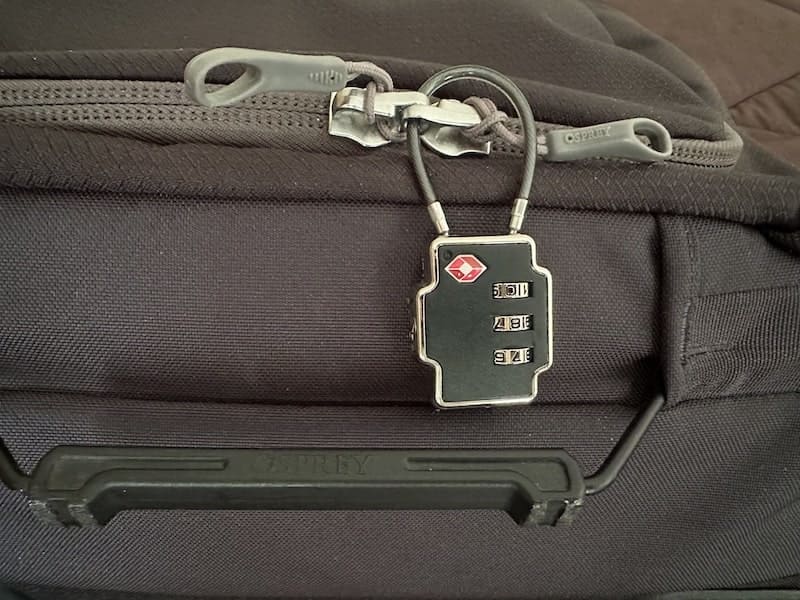
10. Easy storage
The spring frame collapses for efficient storage and transportation.
11. All Mighty Guarantee
A company that stands behind its product with an unlimited warranty has earned my loyalty as a customer. When my Farpoint 40 fell off a motorcycle in New Zealand and suffered significant road rash, Osprey’s representative in Canada sent me a new bag. My review has the details.
(ii) The Osprey Daylite Carry-On Wheeled Duffel 40 in action
Below are several highlights of my experience travelling with the Osprey Daylite Carry-On Wheeled Duffel for 46 days.
1. Carry-on dimensions
Several reviewers on various sites question the accuracy of the advertised length of the Daylite at 21.5 in / 54.61 cm. The result was over 22 inches when I measured the length. Most international airlines, including those on my itinerary (Air Canada, Air Mauritius, Emirates, and LOT Polish), have a stated length of 55 cm / 21.5 in. However, the width and depth of the Daylite are both less than the stated measurements of these airlines. The discrepancies could become an issue if passengers are asked to use a luggage sizer, given that the length of the back is rigid and can’t be compressed to less that its actual length.
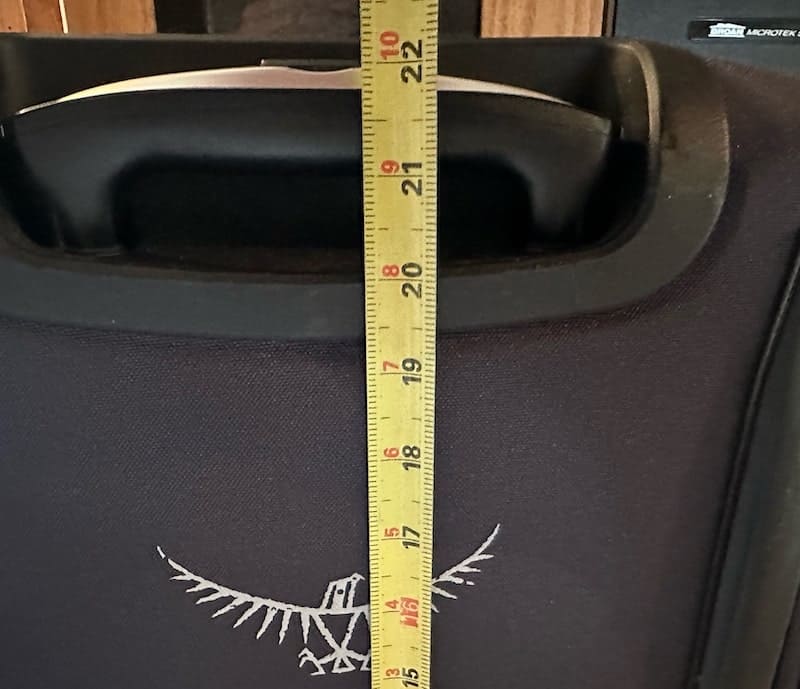
2. Different modes
I aimed for a packed weight of 8 kg (and a maximum of 10 kg). The additional 2 kg is noticeable in backpack mode; the extra weight was a non-issue in rolling mode. Compared to previous trips, my body appreciated a break from constantly hoisting a bag on and off my back on travel days.
One of the main reasons I purchased the Osprey Farpoint 40 travel backpack was the harness, which included a sturdy hip belt and sternum strap. These features are missing from the Daylite hybrid bag, so I appreciated the opportunity to test the bag at an outdoor store. A worker at the Mountain Equipment Company in Halifax loaded the Daylite with 20 lb / 9 kg of stuff and walking around the store felt comfortable.
I visited the store having watched several YouTube videos on various hybrids where a common theme emerged: rolling mode dominated most trips. This led to my placing less importance on a robust hip belt and sternum strap. Rolling mode dominated my African experience and I attribute it to the two sturdy wheels built for various terrain. Another contributing factor is that the bag is small and light enough to switch to duffel mode and lift for short periods using the top grab handle.
After many years of travelling with a backpack, rolling mode required a mind shift concerning security. Sometimes, enjoying a snack or checking my phone required two hands, and my bag was left temporarily unattended and out of sight. An inexpensive safety wrist strap designed for baby strollers or dog leashes might be a handy travel aid while developing the necessary vigilance to keep my bag within reach on travel days.
3. Capacity
I was surprised at how much I could pack in the main compartment, more than my Osprey Farpoint 40. The wheels and rails of the telescoping handle consume very little internal space, and it’s easy to pack around them. The internal compression straps were effective, and at no time did I miss having external compression straps.
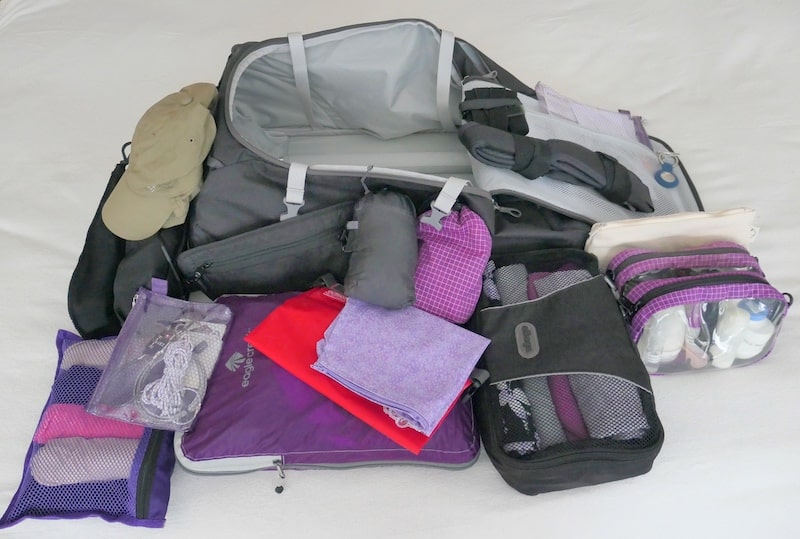
4. Pockets
The ID slot accessed via the top brain pocket accommodates a business card. Although the top pocket is advertised as a ‘convenient 3-1-1 top pocket’ for a liquids bag, it was too tight a fit for my one-quart/one-litre bag to slide in and out. The full-length side pocket is perfect for quick-access items. The deep front pocket has a weather flap over the zipper to provide additional protection.
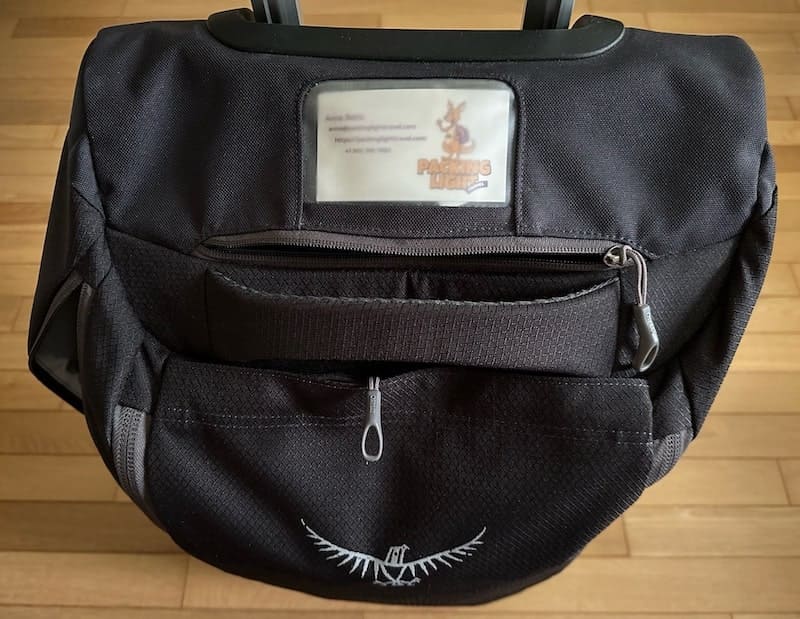
5. Wheels
The wheels performed flawlessly on both even and rough terrain. I’m confident a four-wheel spinner would not have fared as well; I appreciated my choice on many occasions.
6. Grab handles
The two grab handles permitted easy access to the overhead bins. A third grab handle on the side would have helped carry the bag for short periods.
The metal support stand worked well as a grab handle and its primary function. My bag remained upright and stable at all times in the standing position.
7. Durability
On regional aircraft in Southern Africa, overhead bins were too small for 40-litre bags. In these cases, bags were gate-checked on the tarmac before boarding and collected from the tarmac when deplaning. My Daylite came home without any visible signs of wear and tear and mirrored that of many reviewers who checked their bags.
8. Two-rail handle
A two-rail telescoping handle is recessed within a protective housing. It accommodated a luggage bungee strap beautifully. I’m not convinced a single-rail handle would have worked as well. I’ve seen reviews of one-rail handle bags where a second bag with a luggage sleeve rolls around the single stem or it’s difficult for a personal item to remain secure. When my personal item wasn’t nested inside the Daylite, it rested on the top of the bag, securely fastened with the bungee strap.

9. Removable backpack straps
I appreciated that the backpack straps could be removed and left at home. While not a significant amount, this would reduce the bag’s weight by 150 g / 5.3 oz, which is dead weight if a traveller has no intention of using backpack mode. I removed mine from the deep front pocket and stored them in the long side pocket, compressed with elastic utility straps. This left the front pocket free for other gear, given that the position of the zippers makes access to the main compartment difficult when the bag is in standing position.
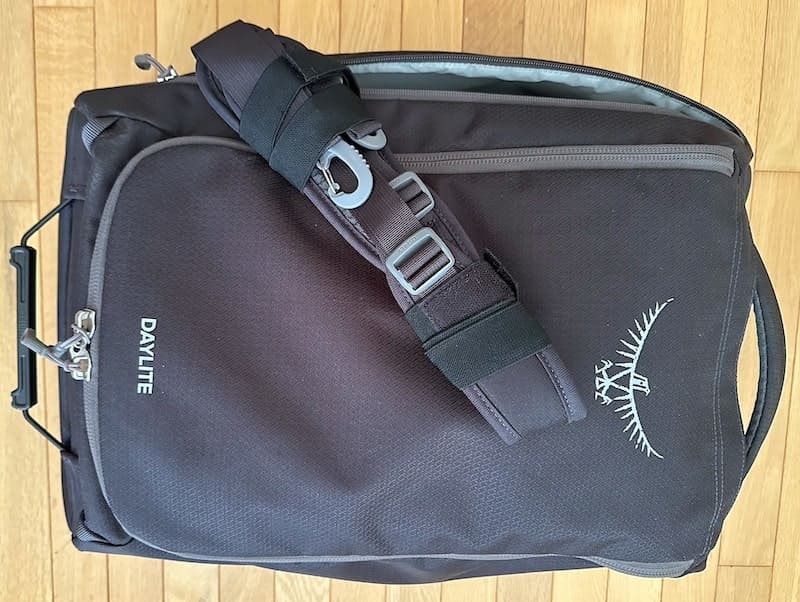
10. Ideal for nesting
The roomy single compartment characteristic of duffel bags was perfect for the nesting packing style. Nesting is a form of one-bag travel where packable secondary bags, empty or fully or partially packed, nest inside the main bag until needed. Moving to and from nesting mode is faster when pouches, cubes, and other packing organizers contain what’s needed when transferring to a personal item or day bag. The main compartment and the long side and front pockets of the Daylite accommodated various organizers packed in nooks and crannies.
Conclusion
If you appreciate the ability to roll, carry, or backpack your travel gear, the Osprey Daylite Carry-On Wheeled Duffel 40 deserves serious consideration.
If you found this post helpful, please share it by selecting one or more social media buttons. Also, would you like to join the conversation? Have you travelled with a hybrid travel bag? If so, which one? Please share your thoughts in the comments. Thank you.
Might you be interested in these related posts?
- Packing list: 46 days of one-bag carry-on travel by nesting
- How to travel with just one carry-on bag using nesting
- How to use a bungee luggage strap with a rolling suitcase
- Osprey warranty review: I’m now a customer for life
- 33 Features of a perfect carry-on bag: buying guidelines
- 14 Best standard carry-on bags according to travel bloggers
Care to pin it for later?
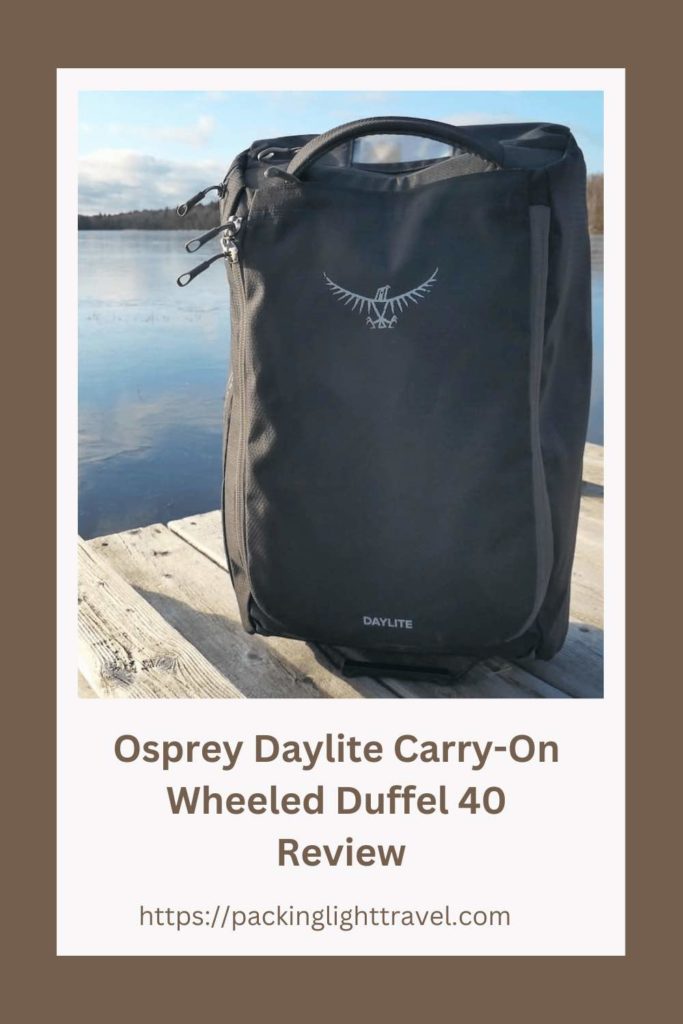
The Amazon links in this post are affiliate links. This means that if you click on one and purchase something, you don’t pay more but this site earns a small commission which helps cover the costs of maintaining Packing Light Travel. Thank you for your support.

